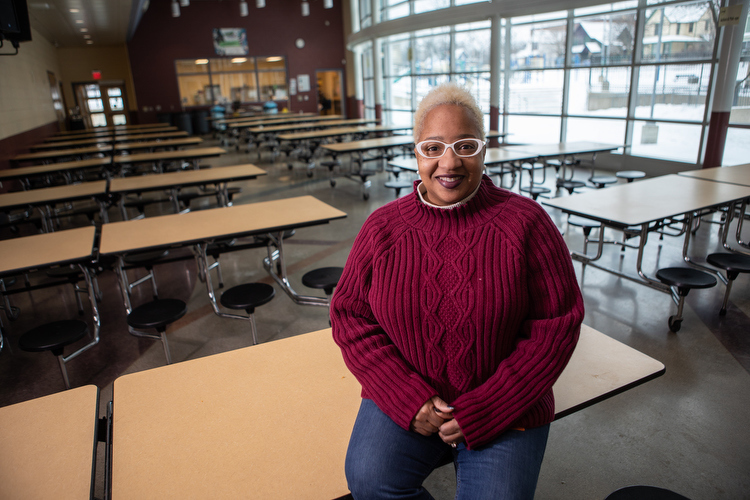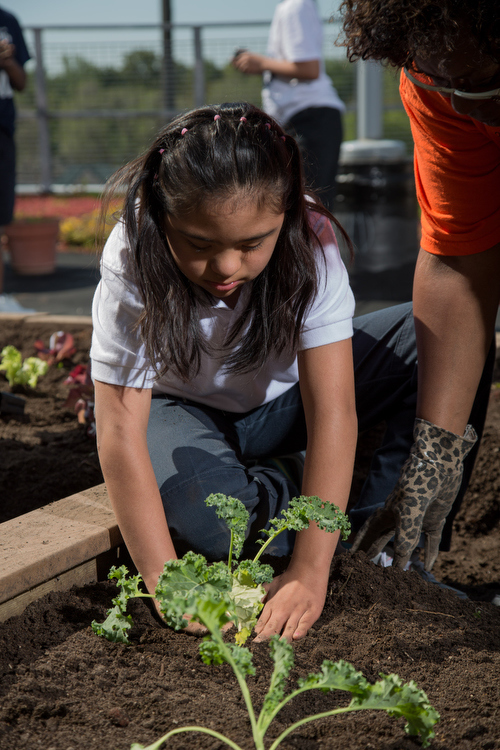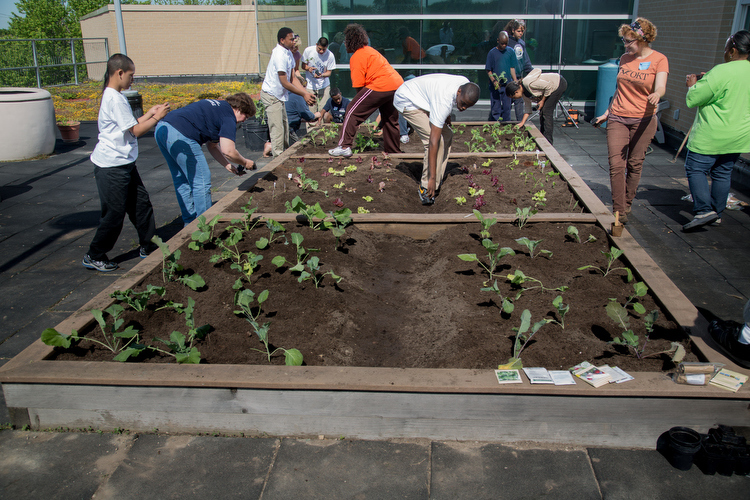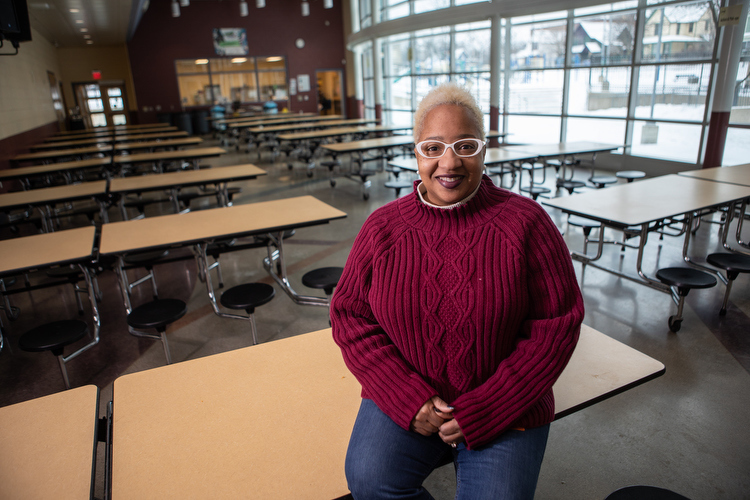There’s a supermarket a few miles down the road, but a gas station convenience store just on the corner. With just $5 for food and transportation, what’s the better choice? Moreover, where will the next meal come from?
This is a reality that many families in Michigan face every day. Food insecurity affects 1 in 8 Michigan residents, and 1 in 5 children, according to the most recent report by Feeding America West Michigan.
For those feeling hungry and stranded by food apartheid, the best options may not feel like the easiest. But convenience and good nutrition are not necessarily mutually exclusive. In a community of resources, educators, growers, and supportive neighbors, previously underserved families are finding sustainable and nutritional food sources through a variety of educational institutions. Across the state, organizations are helping neighbors build knowledge and sustainability to create positive change in food access.
Thinking locally
To get the most for that $5, the nearest farmers market is the way to go, says Our Kitchen Table director Lisa Oliver King. “Your dollars will stretch further there than a retail store,” she says.
If you have time to cultivate, even better. A seed exchange can make $5 worth of food last year round with fruits, vegetables, and edible herbs and flowers. This is sage advice from King and her fellow OKT volunteers. They manage the Southeast Area Farmers Market, serving between 1,000 and 1,500 southeast Grand Rapids residents at Martin Luther King Jr. Park and LINC UP, where around 90 percent of vendors are women of color, “growing clean food within the neighborhood,” King says.
Many of the markets’ clientele come from regions of food apartheid, and more than half of the sales at these markets involve food assistance dollars, King says, “which are warmly welcome.”
OKT has literally spread the seeds of nutrition literacy by providing dozens of households in West Michigan with “grub boxes” of 48 organic starter food plants grown at Blandford Farm. They provide ongoing support with weekly garden coaching visits throughout the growing season, and offer containers or raised beds, basic garden tools, and composted soil.
King and her team also host “Cook, Eat and Talk” events featuring in-season produce made into affordable, easy meals. Meanwhile, a registered dietitian is working with the students, families, and caregivers involved in the program, helping them choose fresh fruits and vegetables, read and understand nutrition labels, choose healthy ingredients, and understand the difference between healthy and unhealthy fats and sugars.
“Most of these events were open to community as well so we reached additional folks,” King says.
OKT’s Program for Growth works with pre-K, kindergarten and middle school students, their families, and their communities to combat lead poisoning through diets focused on fresh produce. Participants are also led through hands-on learning sessions that help them build a “food portfolio.”
“This activity starts by doing a ‘Food Map’ of one’s neighborhood,” King says. “[That is] brainstorming about all of the places food are available to you—whether it be farmers market, ethnic stores, grocery stores, gardens, pantries, fast food, corner stores—every possible source of food that is accessible.”
Next, they look at which of these locations honor food assistance dollars, offer affordable pricing, all while asking, what is the true cost of the food?
“The fast food value menu may seem like the best deal until you count the costs of sick days, obesity, behavior issues, and medical visits that come along with diets build on fast and junk food,” King says. “Hopefully, this food portfolio will help those facing food assistance cuts to feed themselves and their families.”
 Lisa Oliver King is director at Our Kitchen Table in Grand Rapids.
Lisa Oliver King is director at Our Kitchen Table in Grand Rapids.
True to the spirit of culinary community, OKT shares everything with its stakeholders from meal planning and shopping tips, to low cost, healthy recipes that make the most of local produce.
A few years ago, King recalls, a woman named Toni joined OKT as a home food grower. Volunteers worked with Toni to help her grow food in containers at her home, which soon flourished and provided her with several nutritious staples.
Toni started cooking up her produce for friends and neighbors before joining OKT as a peer educator. She developed many of the recipes OKT still shares today, and led a season of Cook Eat and Talk events.
“Toni has a chronic illness and her homegrown produce and food sense helped her live better with it for years,” King says. “While she is no longer able to teach with OKT, she continues to grow food and shop pantries in order to cook for her neighbors, church and family.”
Neighboring communities
A few area codes east of west Michigan, food apartheid is just as crippling. In 2009, roughly half of Detroit, with a population of 916,000, was considered a “food desert,” according to Time Magazine.
The term “food apartheid” is considered more appropriate than “food desert” for several reasons. One being a desert is not always as barren as the name implies–deserts can still support a vibrant community of life. Another reason is the fact that low-income areas more than one mile from a supermarket, the definition for either term, are not naturally occurring. It’s a “history of development and planning policies that failed to consider the community’s food needs, and an underlying economics within both the neighborhood and the broader food industry – such as supermarket industry consolidation – that make such ‘deserts’ possible,” the Center for Health Journalism reports.
A decade after the Time article, data recorded by the Detroit Food Policy Council found that at least 30,000 Detroiters do not have access to a full-line grocer. Moreover, 48 percent of Detroit households are food insecure. That may seem like little change, though now there’s much more activity at the grassroots level, like the work of Brightmoor Artisans Collective.
By offering training in food systems, business basics, culinary skills, and community engagement–along with a great lunch menu in its Artisans Café–the collective supports urban neighborhoods in Detroit. Brightmoor’s Community Creation Space offers daily programming for younger residents and their older neighbors to participate in activities centered around education, creativity, and wellness. The Brightmoor Artisans Farmers Market is held every Friday from 4-7pm between June and October. And Brightmoor’s newly finished commercial kitchen and classroom space is home to educational programs and workshops led by community members around small business development, healthy cooking, food preservation, and more.
One of the most well-attended events Brightmoor facilitates is a free drop-in summer camp for youth, held Mondays through Fridays.
“They could be there for eight hours if they wanted to,” says program manager Brittany Bradd. “We serve breakfast, lunch, and dinner. Our kids’ cooking classes are pretty much always full.”
Once winter sets in, Brightmoor’s programming slows down, but good food is still a priority. In community kitchen classes and other indoor activities, the center continues to promote locally sourced food.
“We’ve got the benefit of having a lot of small farms, as well as a few large ones,” Bradd says. “There’s a lot of food in the neighborhood that’s being grown. And so a lot of the kids at this point, especially kids that have been coming to B.A.C. over the years, they are pretty aware of most of those gardens and even worked at some.” A student helps tend a garden through work with Our Kitchen Table.
A student helps tend a garden through work with Our Kitchen Table.
People that come to Brightmoor are bound to have conversations about food: How it’s made, how it tastes, and most importantly, where it’s from. Participants come to understand the difference between food shipped from another continent and something picked up from a neighbor’s backyard. They also learn the implications of that food winding up in the trash.
“We’ve been hearing the participants bring it up later, how much food is wasted and how many people could be eating this food,” Bradd says. “Sometimes it’s just a little bit of like a shock or they didn’t necessarily realize that that was the case.”
Brightmoor invites local farmers, businesses, non-profits, and others–about 50 organizations in all–to lead classes and seed those conversations. In turn, many of the youth who participate in these classes are later hired on by their former instructors.
“They’re not only learning about growing the food, cooking the food, or eating the food, we’re also selling this food,” Bradd says. “They’re seeing a lot of different ways in which it connects.”
Statewide Initiatives
A large part of the approach OKT and Brightmoor take to promoting nutritional literacy takes place in non-traditional classrooms. Likewise, statewide initiatives rely on educators.
Farm to Institution specialist Colleen Matts has been involved with the Michigan State University Center for Regional Food Systems since 2007, and from 2011-2018 saw more than 70 grantees—eligible Michigan K-12 schools/districts and early care and education programs—benefit from the MI Farm to School Grant Program.
In 2004, only 11 percent of school food service directors in Michigan were purchasing local food, In 2017, at least 60 percent of the schools tracked by the Center for Regional Food Systems were purchasing local food.
“Informed food choices should be part of our educational infrastructure, beginning early as part of a continuum for thriving communities that support children and their families reflective of our various cultures and backgrounds,” Shedd says.
Matts and her colleagues with the 600-member Michigan Farm to Institution Network (MFIN) also run the Cultivate Michigan program, a statewide local food purchasing campaign that helps Farm to Institution programs grow and track their progress. Cultivate Michigan involves 72 institutions and eight other types of businesses as members, including K-12 schools, colleges, hospitals, and senior centers, and Matts is hoping those numbers continue to grow.
“We can amplify the voice of the food buyers and what they’re interested in buying, and communicate with the supply side of those transactions,” Matts says.
Farmers, food processors, food hubs, and distributors also participate. In turn, this furthers one of the main requirements of the Michigan Good Food Charter, deeming that at least 20 percent of the foods served in participating institutions should come from Michigan sources by the year 2020.
According to Matts, it’s a reasonable goal, and some schools are on target.
“I think the culture is shifting in Michigan,” she says.
“We’ve always had champions who have been out in front and have been doing this work for a long time. But I think now, the general feeling is that it’s the right thing to do. And it’s the right thing to help get good food to kids and to invest in the local economy and to support local businesses and local firms. It’s now the norm and not the exception.”

This story is part of “Michigan Good Food Stories” a series that explores access, equity, and sustainability in Michigan’s thriving food economy. This work is made possible by Michigan Good Food and is supported by the W.K. Kellogg Foundation.
Read more in this series.
Photos by Adam Bird

